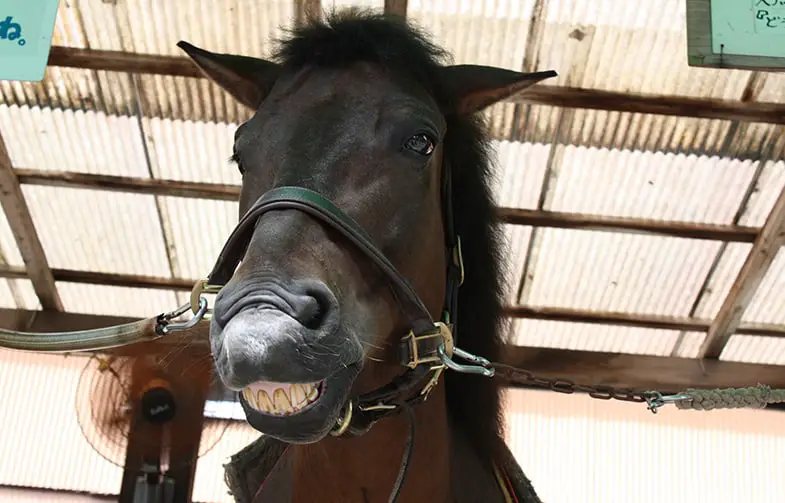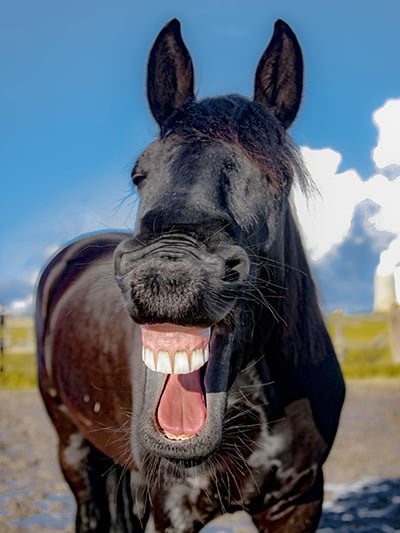The other day I was talking to my equine dentist when she told me that some owners brush their horse’s teeth. This was something completely new to me and at first, I thought she was joking but she assured me she wasn’t. With this in mind, I decided to investigate this and was surprised by what I discovered.
Can you brush a horse’s teeth? You don’t need to brush a horse’s teeth but doing so can help to prevent the build-up of plaque and tartar. It can also help to stop cavities developing in horses that have sweet treats or molasses in their diet.
Do you need to brush your horse’s teeth?
There’s a big difference between whether or not you can physically brush your horse’s teeth and whether they actually need to have them brushed. The simple answer is that no they don’t need to be brushed but as I say that’s the simple answer and there are times when it can be beneficial to brush your horse’s teeth.
Horses are able to clean their teeth naturally as they eat grass and hay or drink freshwater, they also don’t usually have gaps in their teeth so there’s not normally anywhere for the food to get stuff. On top of this horses’ teeth constantly grow so don’t need to be cleaned as often as ours do.
That said though if your horse has a sweet diet the molasses can sometimes cause cavities which can be painful for your horse. Most of the time this isn’t a problem (as water can wash the teeth) but occasionally it can damage them, especially if your horse doesn’t have a straight bite.
Brushing your horse’s teeth in between checkups can not only help to keep plaque and tartar at bay but can also be a good way of checking them for any problems. It’s also worth pointing out that, if you show your horse, some judges will look at a horse’s teeth and mark them down if there’s any food debris.
I read somewhere that removing loose food from your horse’s teeth will help with administering oral medicine as there’s nothing for them to spit out. I honestly don’t know whether or not this is true, but it certainly makes sense.
How do you brush your horse’s teeth?
If you’ve never brushed your horse’s teeth before then you’ll have to get him used to a toothbrush and having it in his mouth, but with a little bit of patience and time, this can easily be done. If your horse isn’t a biter and is okay with things being in and around his mouth then it’s always best to touch his gums before you start. This will make him aware of the fact that you’re going to be doing something inside his mouth and it won’t be a shock to him.
Use a large, damp, toothbrush to gently brush your horse’s teeth, making sure to avoid brushing the sensitive gums. It’s often better to start with the front teeth as this is where the majority of the food debris can be found. Once you’ve done those, and if your horse lets you, you can move on to doing his back teeth but take care when doing this because your horse will be free to close his mouth whenever he wants to.
I asked my equine dentist what type of toothbrush she recommended and she suggested one with a large head, she also said that horses don’t have nerves in their teeth so can’t feel them being brushed. With this in mind, I found these on Amazon and thought they were perfect, and my equine dentist agreed.
All horses are different and will react differently and while most horses are accepting of something in their mouth (even if they don’t like it) some may bite or shy away. This is why it’s important to pay attention to your horse while you’re brushing his teeth and stop if he’s unhappy.
If you’re not keen on using a toothbrush to clean your horse’s teeth but still want to get rid of any bits of food then you can use a damp towel to quickly brush the front of his teeth. Doing this after a ride as part of your grooming routine will help to make it normal for your horse, in time you may even find your horse expecting it and opening his mouth for you.
How often should you brush your horse’s teeth?
Most people never brush their horse’s teeth and there are no hard and fast rules about how often you should brush them. The general consensus is that as long as your horse’s teeth are healthy, and that you have them checked regularly there’s no need to brush them at all.
If your horse has molasses in his feed then I’d recommend giving them a quick brush every few days. You can always use a towel to wipe away any food debris in between brushes if you want to.
How do you remove plaque and tartar from your horse’s teeth?
Just like us horses can suffer from a build-up of plaque and tartar that can irritate the gums and cause them to bleed which is why it’s always better to prevent the build-up to start with. If your horse has a lot of plaque or tartar (more common in geldings and stallions) then it’s advisable to have an equine dentist or vet remove it but if there’s not much you can do this yourself, as long as you’re careful.
I spoke to my equine dentist about how to remove the tartar yourself and she suggested that a dental scaler that’s been designed for dogs (such as this one which is available on Amazon) is the best thing to use. She also said it’s important to avoid their gums and recommended ‘picking’ away from the gum instead of towards it.
Why are my horse’s teeth always discolored?
If you’ve ever looked at your horse’s teeth, and let’s be honest as owners we all should, you can’t help but have noticed just how discolored their teeth are. This is perfectly normal and is caused by a lack of protective enamel around the teeth.
Instead of enamel though horses have cementum which is softer and more porous than the enamel we have. As such it absorbs the pigments from the food the horse eats and can stain easily. Over time, as the horse ages, its teeth will turn from white to yellow and eventually too brown but this is perfectly normal.
If your horse’s teeth are black then it’s probably because they’ve got too much fluoride in their diet or there are high levels of sulfur in their water. If these the case I’d advise you to speak to an equine nutritionist to make sure your horse has the right diet.
I hope you found this article helpful. If you did I’d be grateful if you could share it please as it would really help me.
Recommended products
Over the years I have tried hundreds of different horsey products, from various blankets and halters to different treats. Some I’ve loved, others I’ve hated but I thought I’d share with you my top all-time favorite products, the ones I never leave the yard without. I’ve included links to the products (which are in no particular order) that I really think are great.
- Horse Knots by Reference Ready – If you’re like me and enjoy pocket reference guides then you’ll love this knot tying guide. These handy cards can easily fit in your pocket or attach to the saddle for quick reference. They’re waterproof, durable and are color coded to make them easy to follow.
- Mane ’n Tail Detangler – Even if you never show your horse you’ll need to detangle his tail from time to time (and possibly his mane too) which is always a challenging chore! I’ve found that if I run a little bit of detangler through my horse’s tails every few days it stops them from getting matted up and makes combing them easy, even if they’re coated in mud. I don’t know if I should admit to this or not but it also works wonders on my hair.
- TAKEKIT Pro clippers – Over the years I’ve tried a lot of different clippers and while some were obviously better than others I found these to be by far the best. They are heavier than a lot of other clippers but for me, that’s a good thing, it makes them feel more sturdy and hardwearing. On top of that they have a range of speeds so are just as good for clipping your horse’s back as they are his face. I also like the fact that they come in a handy carry case but that’s not for everybody. The company that makes them is super good and incredibly helpful too, a real bonus these days. The only thing I wasn’t keen on was the fact that it doesn’t come with any oil, but that’s not a major problem as it’s not difficult to buy lubricant.
- Shire’s ball feeder – There are so many boredom buster toys out there but I like to use these every day, regardless of whether or not my horses are bored. I find that it helps to encourage my horses to problem solve by rewarding them with treats (or pieces of fruit) but it also mimics their natural grazing behavior which helps to keep them calm and de-stressed.
- Horse safe mirror – This is a strange one that many people are surprised about but I like to put horse safe mirrors in the trailers as well as in the quarantine stalls. It helps to prevent the feeling of isolation by giving the impression of other horses being around. Being herd animals horses can get extremely stressed when they feel that they’re on their own but with these stick-on mirrors, they believe that at least one other horse is with them.
- Rectal thermometer – I know this isn’t glamourous at all but it’s vital for your horse’s well-being to be able to check their temperature and a rectal thermometer is the easiest way of doing this which is why I’ve added it to the list.
Shopping lists
I’ve also put together a few shopping lists of essential items that I’ve found helpful over the years. I’ve broken the lists down into different categories rather than put everything in one massive list 😉




